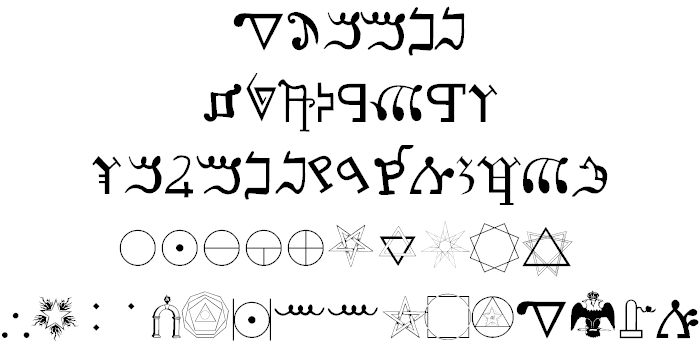
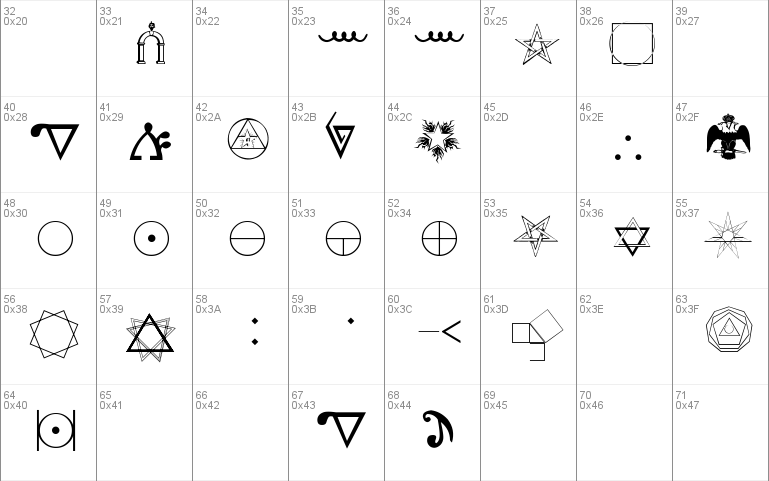
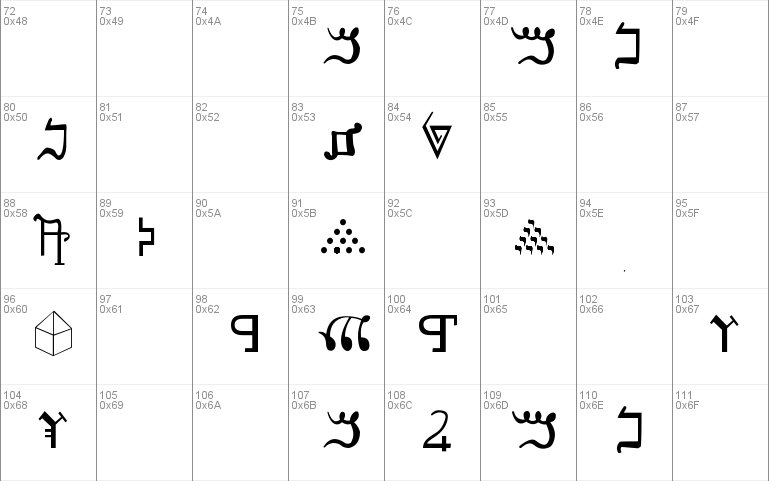
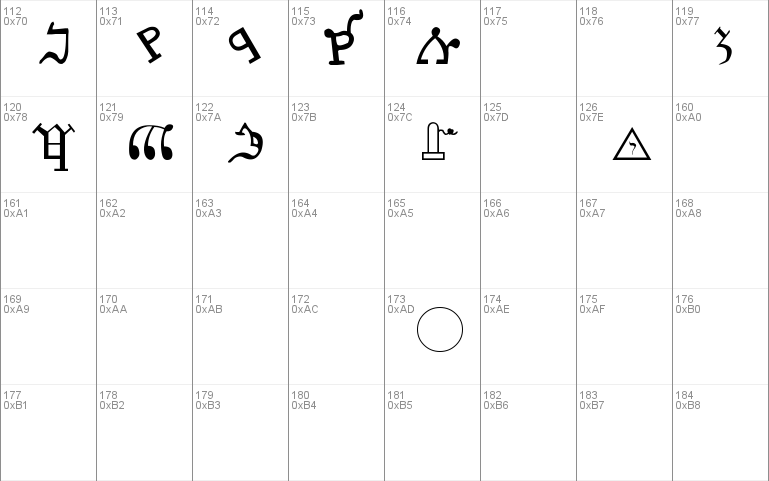
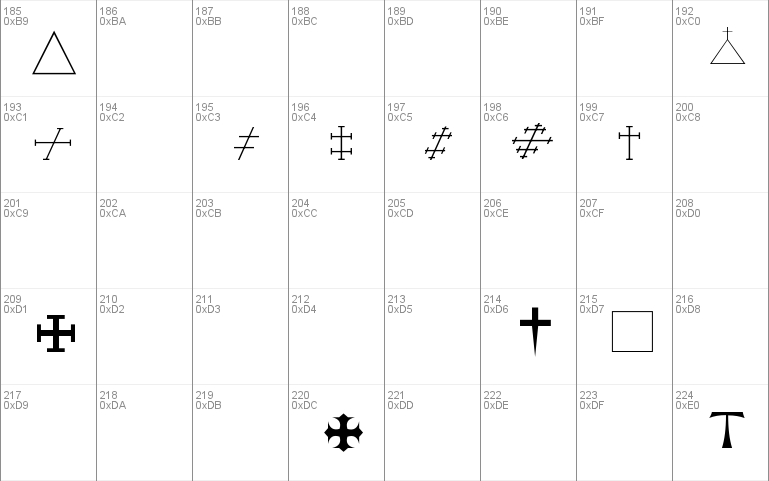
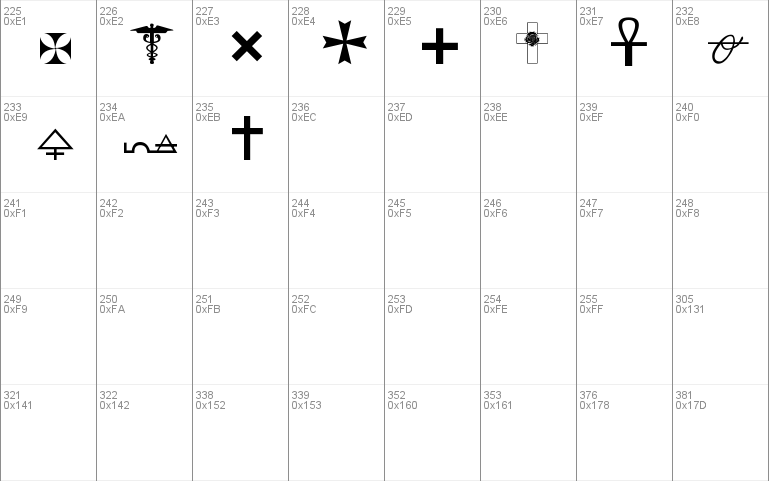
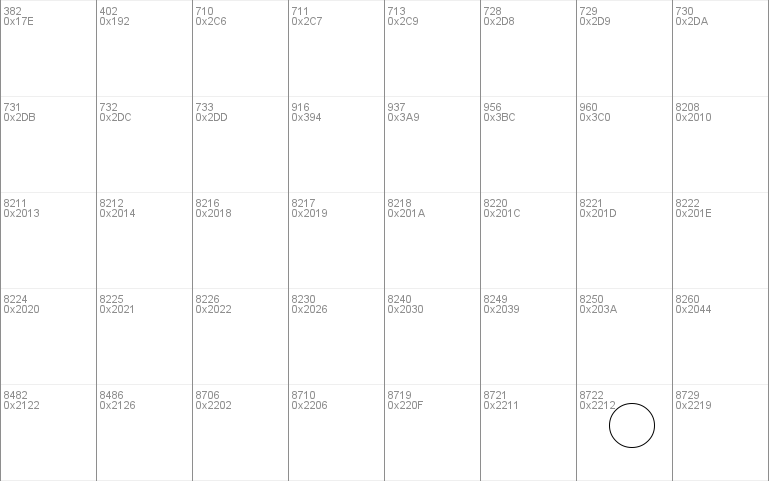

- Styles (1)
- Character Maps
- License







- Free for Personal Use
- Free for Commercial Use
- Modification Allowed
- Redistribution Allowed
Read more
Kadosh Samaritan
A TrueType Font for Windows
Version 1.1
9 February 2003
Shawn Eyer, M.A.
Adjunct Professor
Department of Liberal Studies
John F. Kennedy University
_____________________________________________________
The Samaritan script, also known as Old Hebrew or ketab ibri, is a particularly ornate and fascinating form of the Semitic alphabet. It presents the letters of the Hebrew script in a form closer to the ancient Phoenician roots of the Hebrew alphabet. The characters in Kadosh Samaritan are based on the Samaritan letters as found in the Masonic writings of Albert Pike (1809-1891). This typeface will be useful to Biblical scholars as well as to researchers of the literature of Freemasonry.
Kadosh Samaritan follows the modified Michigan-Claremont encoding scheme found in the popular Scholars Press Hebrew fonts. This allows the user to transform unpointed Hebrew set in a Scholars Press font into Samaritan characters simply by changing the font. To facilitate this function, I have duplicated some characters where appropriate because in Tiberian there are special versions of certain letters (kaf, mem, nun, pei, tzadi) when they come at the end of a word. This was not done in ancient manuscripts, and there are no final forms of Samaritan glyphs.
On the many keys unused by Samaritan characters, Kadosh Samaritan offers a number of useful Masonic symbols, with a particular emphasis on the Scottish Rite. Among the supplements to be found are the double-headed eagle, the logo of the Scottish Rite Research Society, and the various crosses used in Scottish Rite signatures.
The Kadosh Samaritan font was created using the Font Creator Program (v3.1.3) by High-Logic (http://www.high-logic.com). This font is governed by the Terms of Use found at the end of this document. Product suggestions, license inquiries and other other concerns may be addressed to Shawn Eyer at [email protected].
Enhancements are planned for this product. These include a better selection of enhanced characters, a Macintosh version and a character-only version which follows the appropriate 16-bit Unicode mapping for Hebrew. The latest version of this font and supporting files may be found at:
http://www.orindalodge.org/kadoshsamaritan.php
Kadosh Samaritan Alphabet Map
-----------------------------
Key Glyph Value Description
) ) 0041 ) (aleph)
b b 0098 b (beit)
g g 0103 g (gimel)
d d 0100 d (daled)
h h 0104 h (hei)
w w 0119 w (vov)
z z 0122 z (zayin)
x x 0120 x (chet)
+ + 0043 + (tet)
y y 0121 y (yud)
k k 0107 k (kaf)
l l 0108 l (lamed)
m m 0109 m (mem)
n n 0110 n (nun)
s s 0115 s (samech)
( ( 0040 ( (ayin)
p p 0112 p (pei)
c c 0099 c (tzadi)
q q 0113 q (kuf)
r r 0114 r (reish)
# # 0035 # (shin)
t t 0116 t (tav)
Additional Mappings for Compatibility
-------------------------------------
C C 0067 C (final tzadi)
K K 0075 K (final kaf)
M M 0077 M (final mem)
N N 0078 N (final nun)
P P 0050 P (final pei)
D D 0068 d (rare alternate for daled)
X X 0088 x (rare alternate for chet)
Y Y 0089 n (rare alternate for nun)
$ # 0036 # (for compatibility with an older Samaritan inscription font)
Kadosh Samaritan Supplemental Characters
----------------------------------------
Key Glyph Value Description
! ! 0033 "without the gates"
% % 0037 pentalpha dextra
* * 0042 Secret Master
, , 0044 Blazing Star
& & 0038 "squaring the circle"
. . 0046 tripunctial mark
/ / 0047 double-headed eagle
0 0 0048 circle
1 1 0049 point within a circle
2 2 0050 "spirit divided"
3 3 0051 "descent into matter"
4 4 0052 quaternity
5 5 0053 pentalpha sinistra
6 6 0054 interlaced hexagram
7 7 0055 heptagon
8 8 0056 octagon
9 9 0057 nonagon
: : 0058 end of sentence
; ; 0059 separator
< < 0060 end of line
= = 0061 47th problem of Euclid
? ? 0063 Scottish Rite Research Society logo
@ @ 0064 point, circle, parallel lines
[ [ 0091 tetraktis
] ] 0093 tetraktis of yods = 10�10
` ` 0096 pointed cubical stone
| | 0124 Amun-Ra hieroglyph
~ ~ 0126 yud in triangle = 14�
� � 0192 18� Knight Rose Croix
� � 0193 32� Prince of the Royal Secret
� � 0195 33� honorary
� � 0196 Grand Cross
� � 0197 S.G.I.G.
� � 0198 Sovereign Grand Commander
� � 0199 K.C.C.H.
� � 0209 Teutonic cross
� � 0214 cross fitchee
� � 0220 cross patt�e fitched
� � 0224 tau cross
� � 0225 Templar cross
� � 0226 caduceus
� � 0227 Cross of St. Andrew
� � 0228 Maltese cross
� � 0229 Greek cross
� � 0230 crux rosa
� � 0231 crux ansata
� � 0232 salt
� � 0233 sulphur
� � 0234 spirit
� � 0235 passion cross
About the Samaritan Script
About the Samaritan Script
This unusual system of writing is an archaic form of Hebrew script. The glyphs correspond to the letters of the Hebrew alphabet (or more accurately, "aleph-beit"). A comparison of the two scripts will reveal that while Samaritan seems very unfamiliar, it in fact resembles the more recognized Hebrew writing in more than a few particulars. For example, nun, gimel, and shin are quite similar. Other letters hardly bear a resemblance, such as yod, and chet. One of the interesting features of Samaritan is the fact that its first letter, aleph, and its last, tov look so similar, unlike in square Hebrew script.
The Samaritan letters are actually based on the most ancient form of Hebrew writing, which was derived from the Phoenician alphabet. According to Yale historian Johanna Drucker:
Old Hebrew developed in the 11th and 10th centuries BC during the time associated in biblical history with David and Solomon; it fell out of use after the fall of the Temple and Babylonian exile in the 6th century BC. Though preserved in the form of sect script Samaritan, old Hebrew was held in low esteem by the rabbinical Jews who adopted a chancellery script of the late Persian empire as the basis of the square Hebrew still in use today. (1995, p. 43)
The paleo-Hebrew script which Samaritan represents became politically-charged. Between 100 BC and AD 150, a time of Jewish revolt against Roman domination, it appears on artifacts from coins to Biblical manuscripts found among the Dead Sea Scrolls. Semitic language scholar John Healy explains that:
The retention of the old script may have had an element of nationalism about it. It was favored by certain Jewish sects, certainly by the Samaritans, who retained it througout the ages. By contrast, the orthodox tradition of mainstream rabbinic Judaism came to be rather hostile to the old script and gave legitimacy to the newly adopted Aramaic script. . . . According to the Mishnah, a collection of Jewish legal ludgements compiled c. AD 200, the Law scroll (Torah), when written in the old Hebrew script (as it was by the Samaritans), did not have about it the same sanctity as adhered to a normal scroll in the Jewish Aramiac script. (1991, pp. 32-33)
The Samaritan culture preserved this script for over two thousand years. Although once numbering over a million people, by the early 1920s there were fewer than 200 Samaritans left in the world. Their language and culture is often wrongly considered to be extinct. But today there are approximately 700 Samaritans, and they preserve and promote their culture entusiastically (Rustow, Liberman, & Deitsch, 2000). Divided between Tel Aviv and Nablus in the contested West Bank, the Samaritans carry on distinct religious observances which remain largely unchanged from ancient times, including the traditional sacrifices at their ancient altar on Mount Gerizim. Their ancient alphabet persists in such diverse examples as their Biblical scrolls, mezuzahs, amulets, and a even bi-weekly newspaper called 'ab (aleph-beit).
Samaritan script is also still in use among a very different population: American Freemasons. In the latter part of the nineteenth century, an American named Albert Pike became prominent as an author and editor of rituals within a particular segment of Freemasonry called the Ancient and Accepted Scottish Rite. The lore of this philosophical fraternity frequently borrowed Hebrew, Greek and Latin words.
In all but Pike�s earliest revisions of the Scottish Rite ceremonies, Samaritan letters appear where Hebrew had formerly been displayed. Although no evidence has survived to indicate Pike�s reason for altering the script, the practical context suggests that he introduced Samaritan to make the rituals seem more authentic to their dramatic setting (in most cases, during the Solomonic period). Additionally, he may have felt that by varying the scripts seen during the degrees (square Hebrew letters were not completely eliminated) it might make the ceremonies seem less sectarian. Masonry--in its Scottish Rite form particularly--regards itself as religiously neutral, and Pike may have felt that too great a reliance on Hebrew lettering could give the impression that Masonry was unduly slanted toward Judaism. While open to all religions, Masonry has mostly been populated by protestants. All speculation aside, Pike�s enthusiastic embrace of the Samaritan script is attested throughout his published works as well as his rituals; an enthusiasm all the more impressive for the fact that he is not known to have justified it. Nor was Pike�s purpose merely to obfuscate the already cryptic lessons given to the initiates. To assist serious students of Masonry, Pike published a key to the Samaritan alphabet in 1878, and it was this chart which formed the source for the design of Kadosh Samaritan (Pike, 1878/1999).
For the last 125 years this long-neglected writing style has found new life among the hundreds of thousands of Scottish Rite Masons in the United States and elsewhere. And while the indigenous usage of Samaritan writing--like the culture that preserved it--once verged on extinction, it remains an important though often overlooked Semitic alphabet, preserving as it does some of the most ancient Hebrew letter-forms.
References
Drucker, Johanna. (1995). The alphabetic labyrinth. New York: Thames & Hudson.
Healey, John F. (1991). The early alphabet. Berkeley, CA: University of California Press.
Pike, Albert. (1877/1962). Liturgy of the Ancient and Accepted Scottish Rite of Freemasonry for the Southern Jurisdiction of the United States, Part II. Charleston, SC: Supreme Council.
Pike, Albert. (1878/1999). The book of the words: Sepher h�debarim. Washington, DC: Scottish Rite Research Society.
Rustow, M., Liberman, S., & Deitsch, E. (2000). Scripture and schism: Samaritan and Karaite treasures from the Library of the Jewish Theological Seminary. New York: Jewish Theological Seminary of America.
About the Designer
Shawn Eyer is a member of the adjunct faculty of the Department of Liberal Studies at John F. Kennedy University in Orinda, California. He holds degrees in religious studies and psychology. His research has focused on the literature of early Christianity, gnosticism and the Greek mystery religions, and is the author of several publications in these fields. His Masonic affiliations include the Northern and Southern California research lodges, the Southern Jurisdiction of the Ancient and Accepted Scottish Rite of Freemasonry, the Grand College of Rites, the Scottish Rite Research Society and the College of the Consistory.
Installation Instructions
Microsoft Windows (3.1; 95/98/ME, NT/XP)
Step One: Uncompress the Archive
Unzip the archive to a temporary directory (or "folder").
Note: Some users have unzipped the font directly into the Windows/Fonts folder. This will not install the font and is not recommended. If this has been done, be sure to remove any Kadosh Samaritan files which may appear in that folder.
Step Two: Open the Fonts Folder
Load your Windows Control Panel and within that, open the Fonts folder. You should see all of the fonts you are using displayed in this window.
Step Three: Install the Font
In the Fonts window, select File>Install New Font. A dialog box will open listing the fonts available to install. Kadosh Samaritan will not be there. Select Browse and navigate to the temporary directory or folder into which you unzipped your original archive. Select OK, and the name "Kadosh Samaritan" should quickly appear in the listing of fonts available to install. Be sure that "Copy font to Fonts folder" is checked on.
Highlight Kadosh Samaritan and the select "Install Font(s)" or the equivalent.
Step Four: Test
Kadosh Samaritan should appear in your Fonts folder. Launch it ("double-click" on it) to see it working. Then load a word processor, select the Kadosh Samaritan font, and try typing some characters in it. If you experience the font not working after being first installed, reboot. Report any persistent issues to me.
Step Five: Clean-up
Once Kadosh Samaritan is installed in the Fonts folder, you may elect to delete the temporary directory or folder into which it was originally unzipped. You may find it prudent to save the PDF or text file which contains this documentation for your reference at a later time.
Macintosh OS X
Step One: Uncompress the Archive
The archive file will automatically decompress to your desktop upon downloading. You will receive this manual in PDF and text formats, as well as the font itself, which will have a .ttf (TrueType font) file extension. Make a mental note of which file this is.
Step Two: Open the Fonts Folder
Fonts are stored in a folder under your Library folder. (If you are not familiar with finding your Library folder, consult your computer�s documentation.) Open your Library and then go into the Fonts folder. You should see all of the fonts you are using displayed in this window.
Step Three: Install the Font
Drag the .ttf file from your desktop into the Fonts folder. The font should automatically install and be ready for use. Note: Do not drag the PDF or text files with it. They do not belong in your fonts folder.
Step Four: Test
Kadosh Samaritan should appear in your Fonts folder. Launch it ("double-click" on it) to see it working. Then load a word processor, select the Kadosh Samaritan font, and try typing some characters in it. If you experience the font not working after being first installed, reboot. Report any persistent issues to me.
Step Five: Clean-up
Once Kadosh Samaritan is installed in the Fonts folder, you may elect to delete the other files which we decompressed to your desktop. You may find it prudent to save the PDF or text file which contains this documentation for your reference at a later time.
Revision History
Version 0.1 13 March 2001 First completed version.
Version 1.0 23 January 2003 Original Release. Addition of special characters. 7-page documentation added.
Version 1.1 9 February 2003 Minor revision. Addition of X and Y glyphs. Installation instructions added to documentation; essay on the history of Samaritan script expanded.
Technical Notes
Development
The Kadosh Samaritan font was created using the Font Creator Program (v3.1.3) by High-Logic (http://www.high-logic.com).
Conversion
Translation to Apple Macintosh TrueType format is planned for a future release.
Compatibility
Kadosh Samaritan has been tested under Windows 95/98, Windows ME, Windows 2000, and Windows XP. It is not compatible with Windows 3.0 or earlier, as these versions do not support TrueType fonts. If you have tested it under other operating systems, especially Windows 3.1, Windows CE or Windows NT 4.0, please let me know.
Unicode
A Unicode-mapped version of the font is planned for a future release.
Terms of Use
Kadosh Samaritan is copyright � 2001-2003 by Shawn Eyer. All rights reserved.
License to Use
License is granted to individual users to utilize this font for research purposes. Commercial uses must be approved by the author.
Distribution
This font may not be redistributed without permission of the author, whether individually or as part of a collection of fonts, via the Internet, CD-ROM, or any other medium; nor may it be distributed without the accompanying documentation and Terms of Use files.
Disclaimer
The author expressly disclaims any warranty for Kadosh Samaritan. The Kadosh Samaritan font files and any related documentation is provided "as is" without warranty of any kind, either express or implied, including, without limitation, the implied warranties or merchantability, fitness for a particular purpose, or noninfringement. In no event shall the author be liable for any damages whatsoever (including, without limitation, damages for loss of business profits, business interruption, loss of business information, or any other pecuniary loss) arising out of the use of or inability to use this product, even if the author has been advised of the possibility of such damages.
Contact Information
Product suggestions, license inquiries and other other concerns may be addressed to Shawn Eyer at [email protected].
The Unicode Character Database is provided as is by Unicode, Inc. Microsoft and Windows are either trademarks or registered trademarks of Microsoft Corporation in the United States and/or other countries. Apple and Macintosh are registered trademarks and TrueType is a trademark of Apple Computer, Inc., registered in the United States and other countries. Adobe and PostScript are trademarks of Adobe Systems Incorporated which may be registered in certain jurisdictions. All other trademarks and registered trademarks are the sole property of their respective owners.


Comments